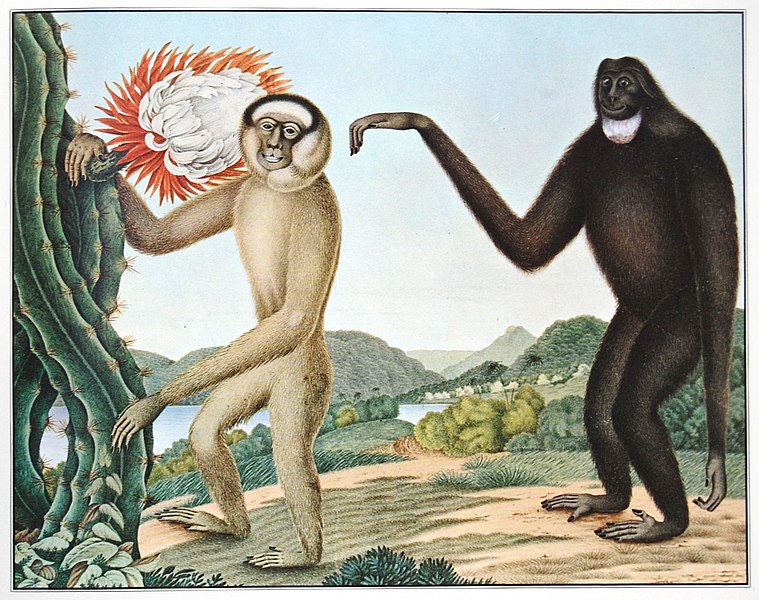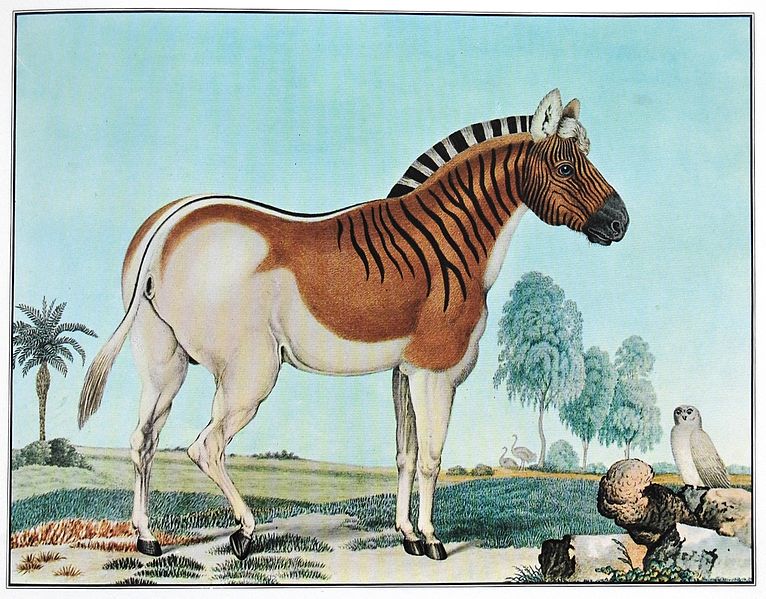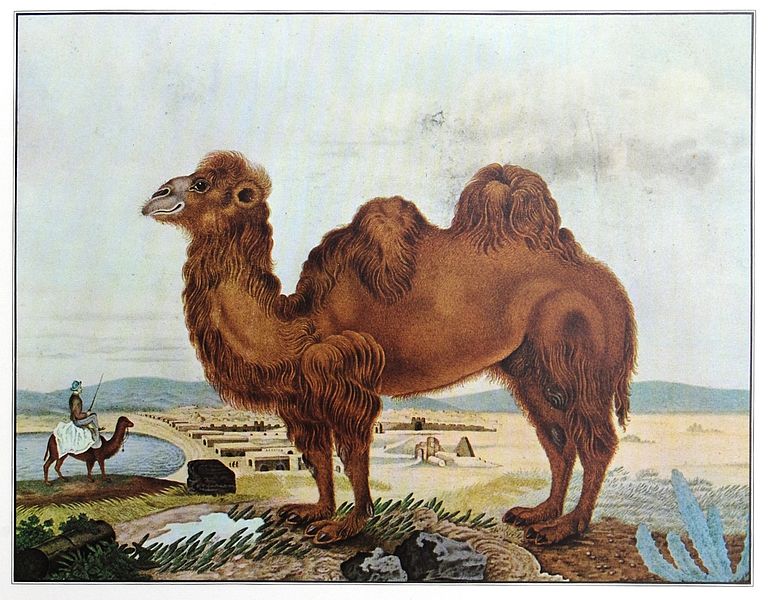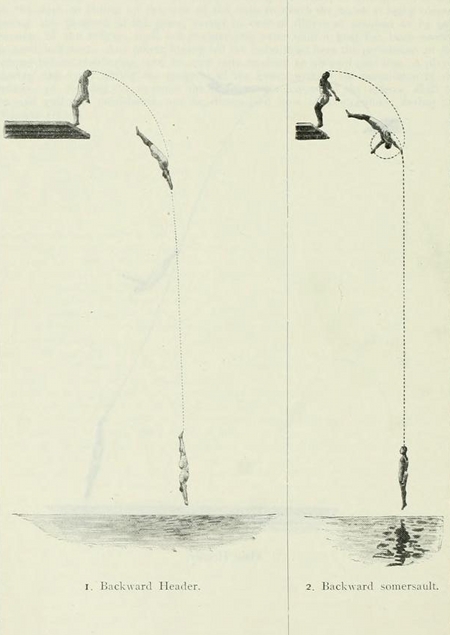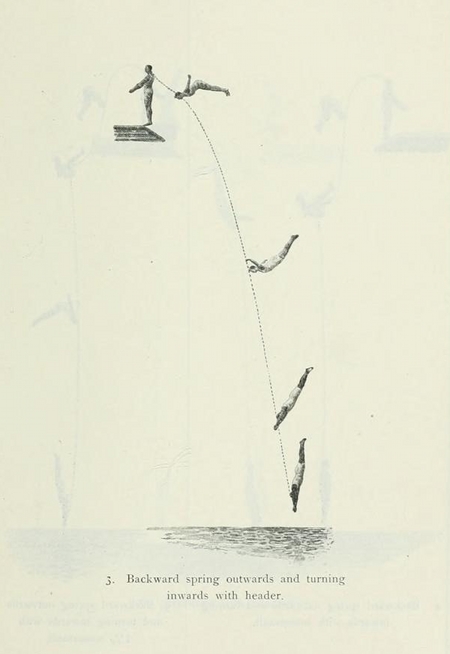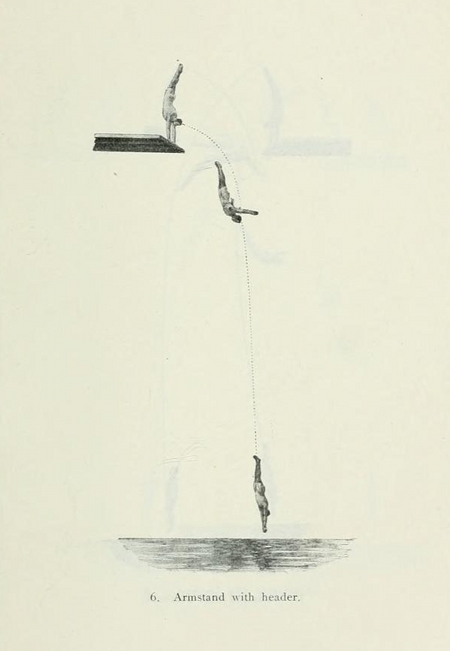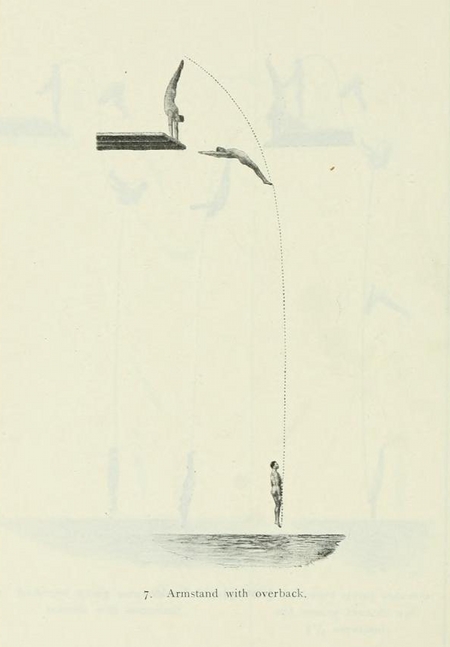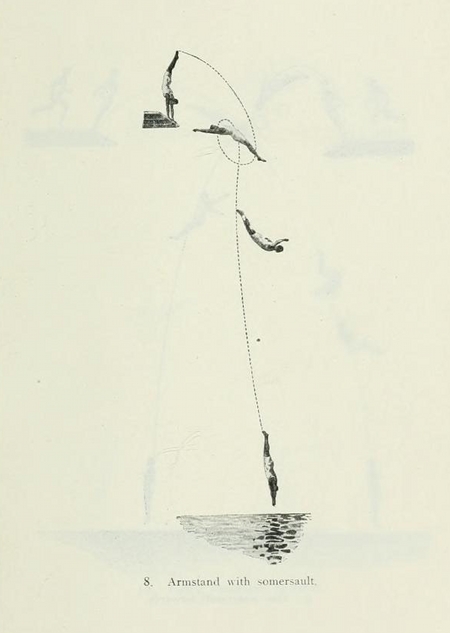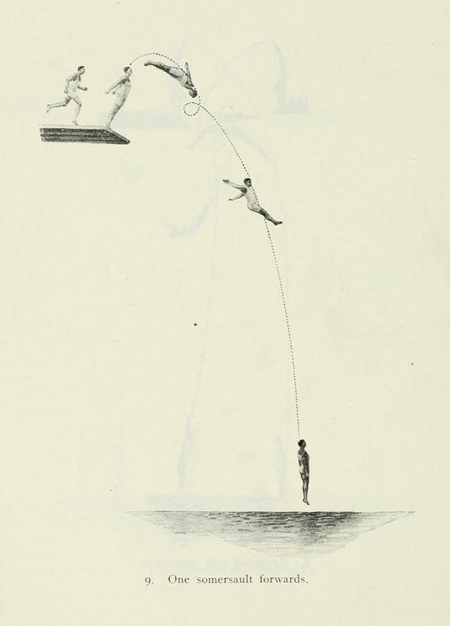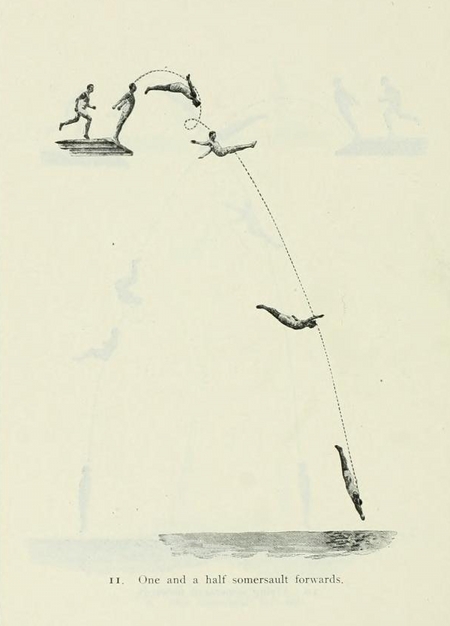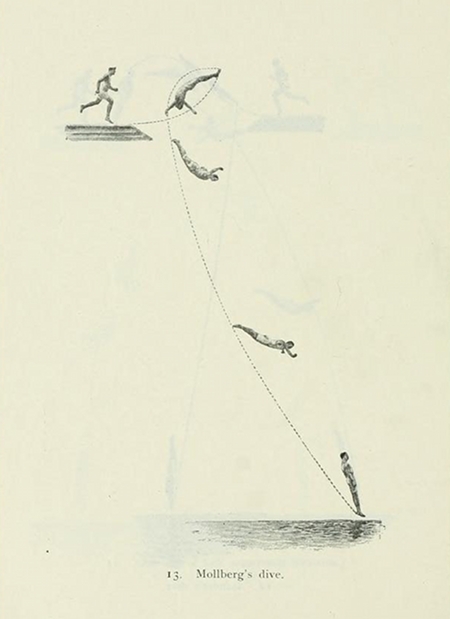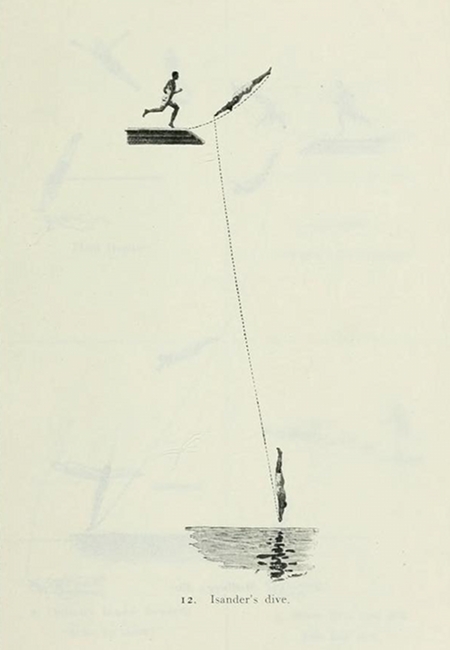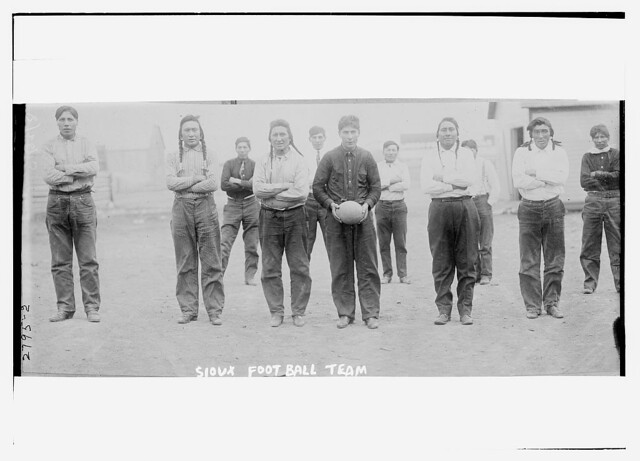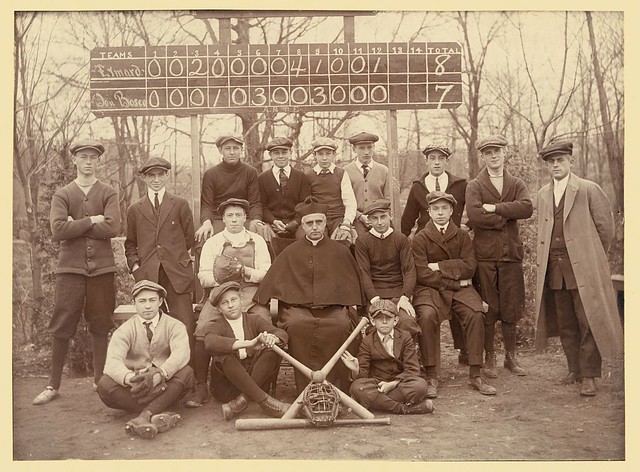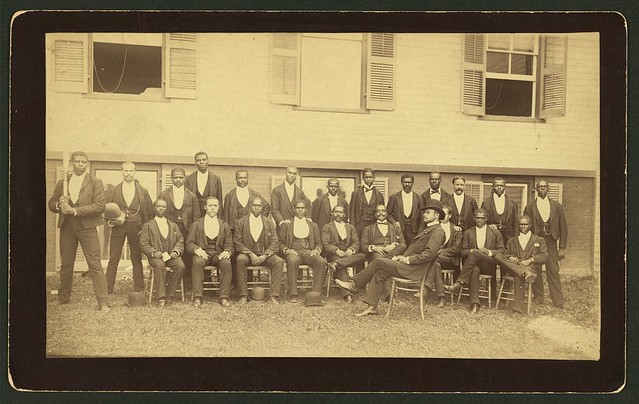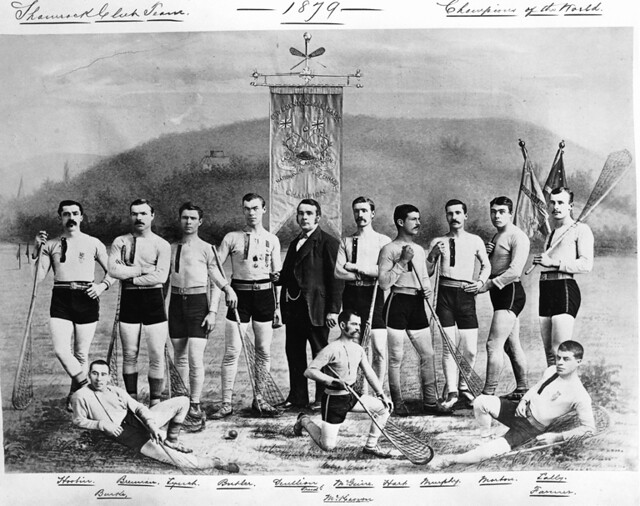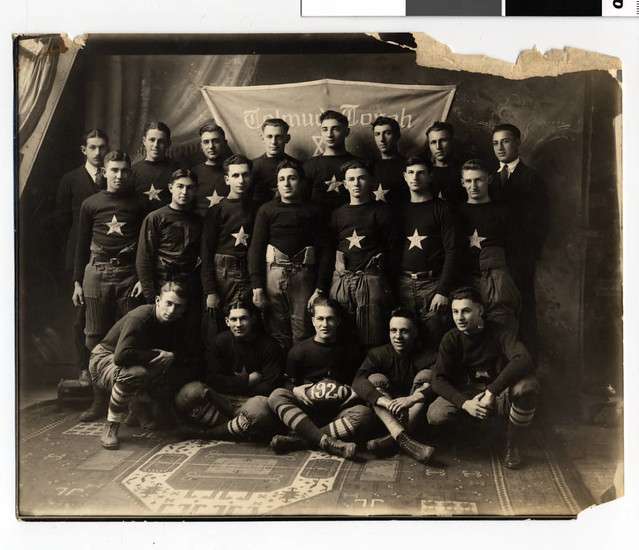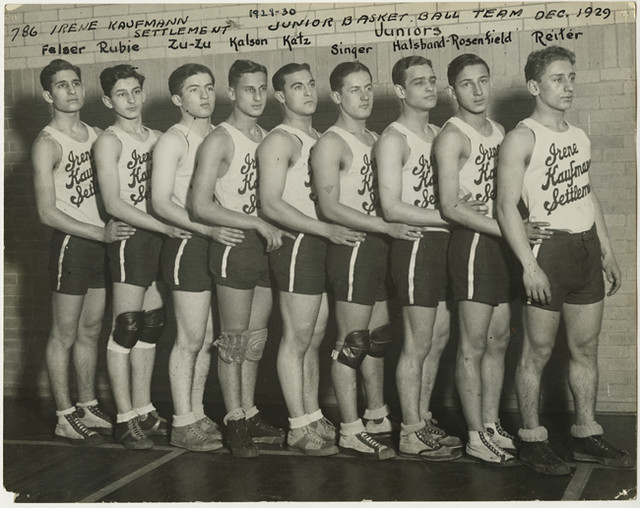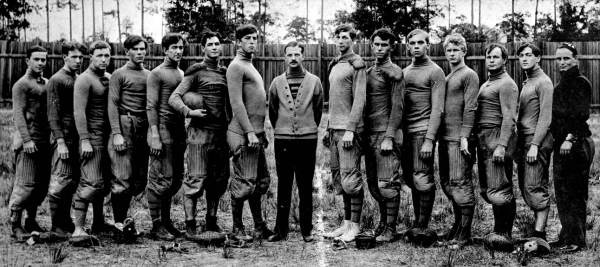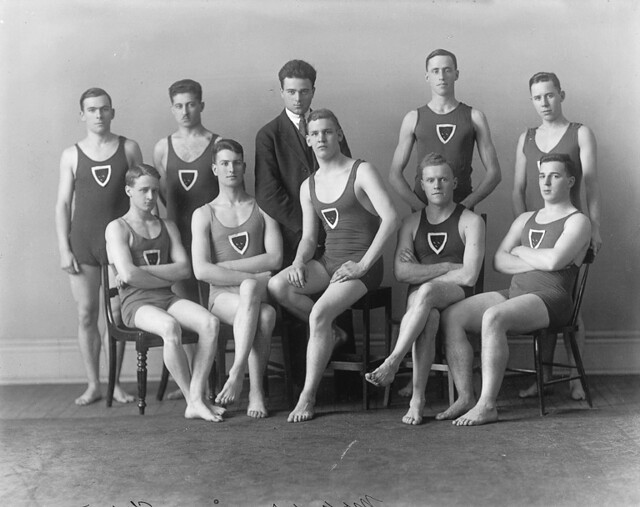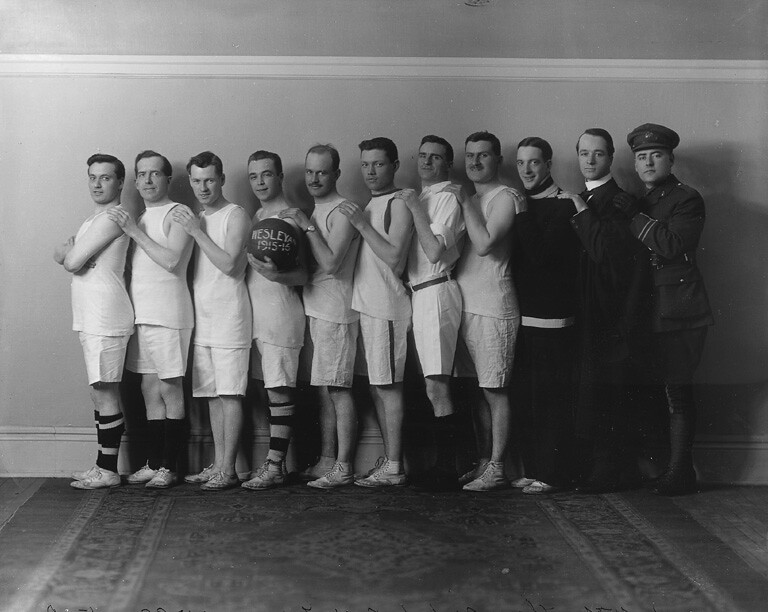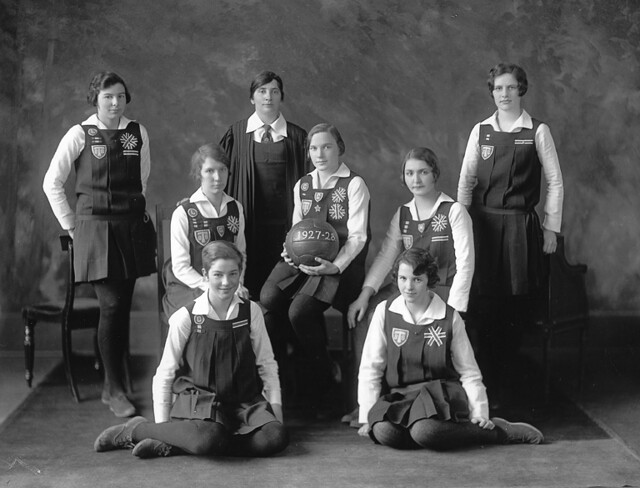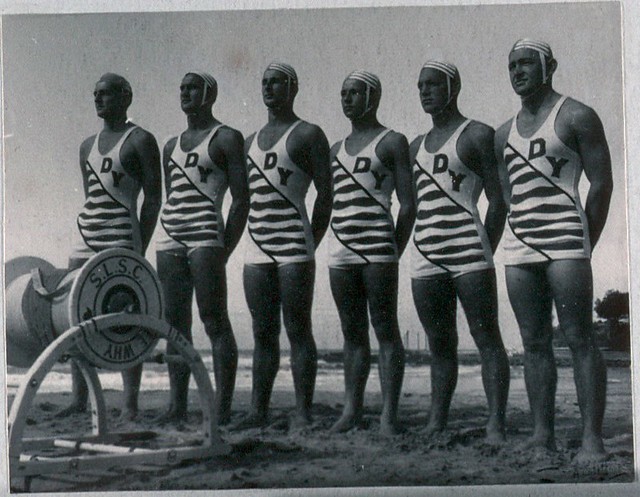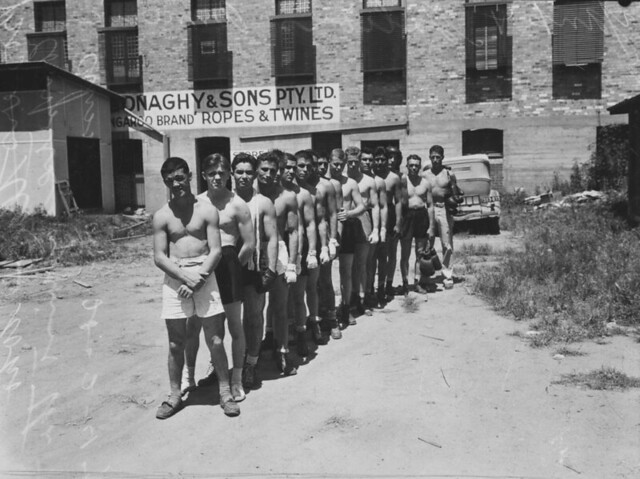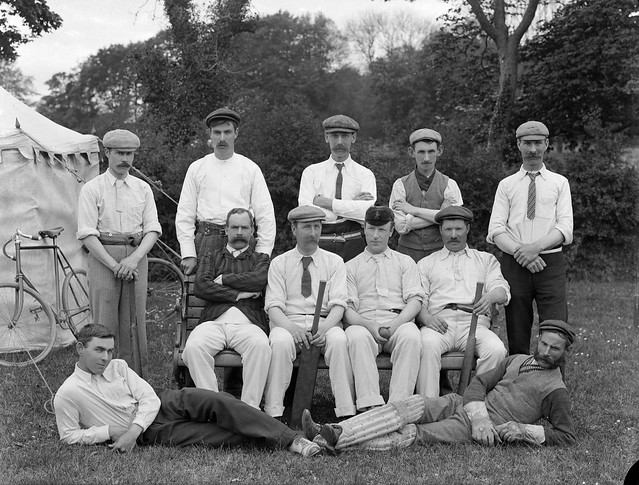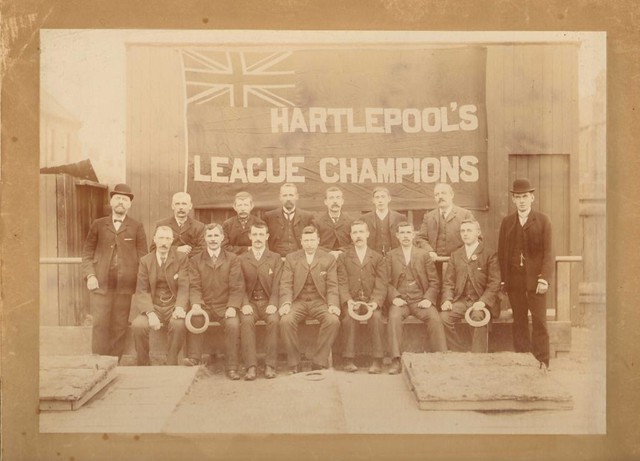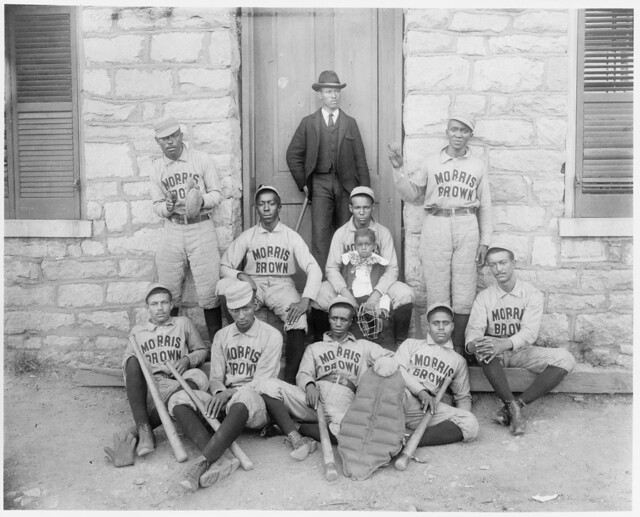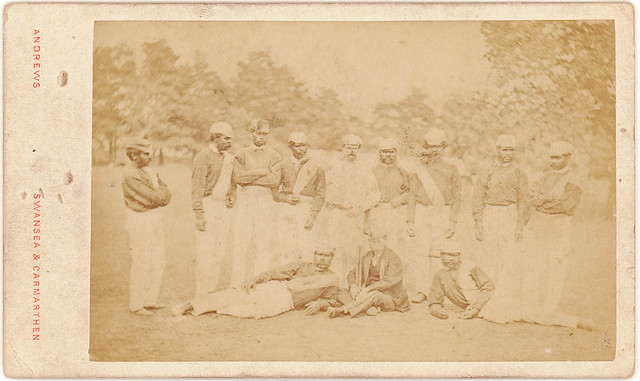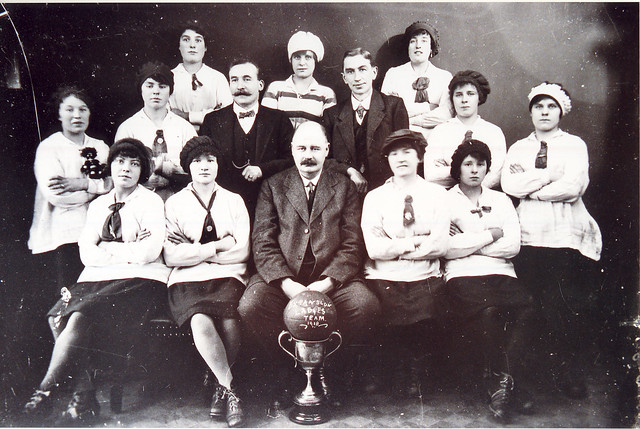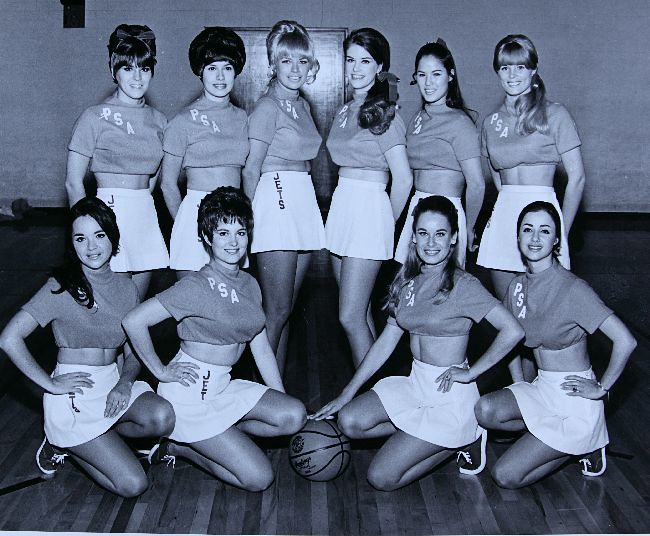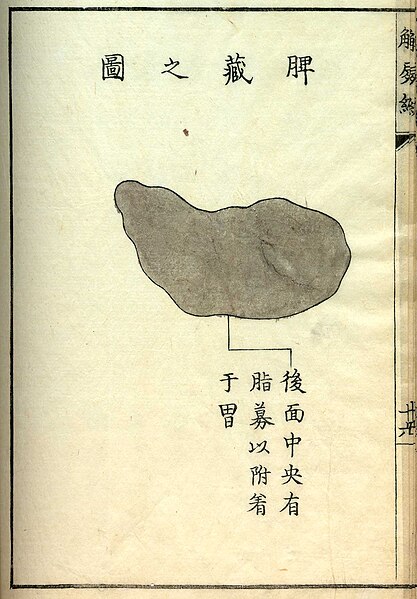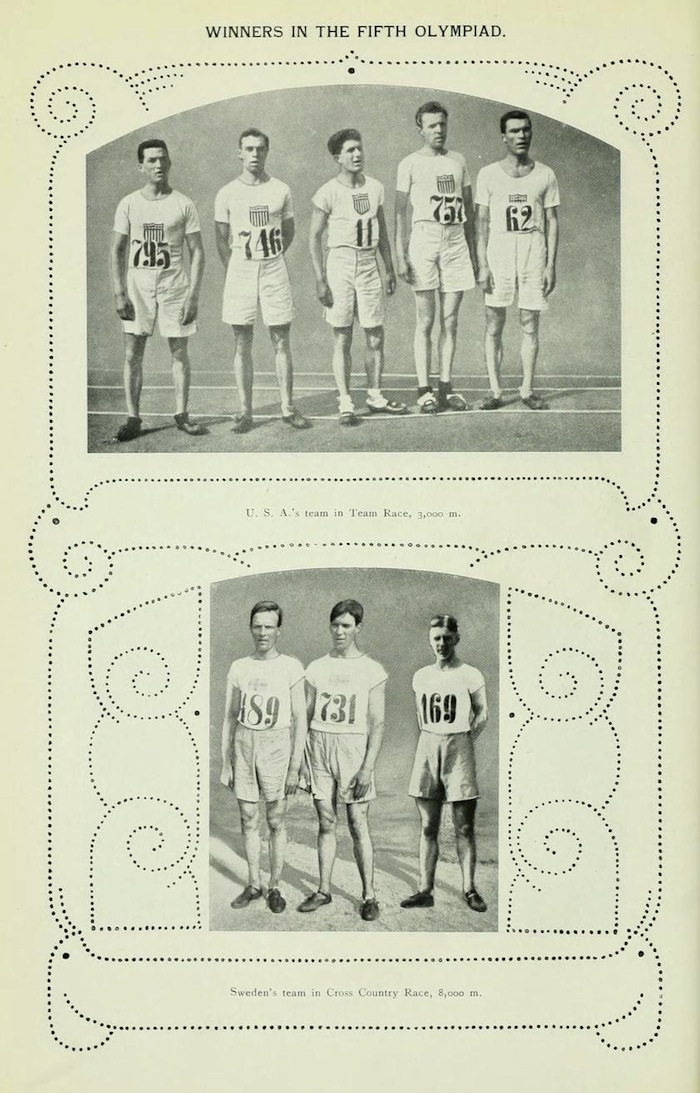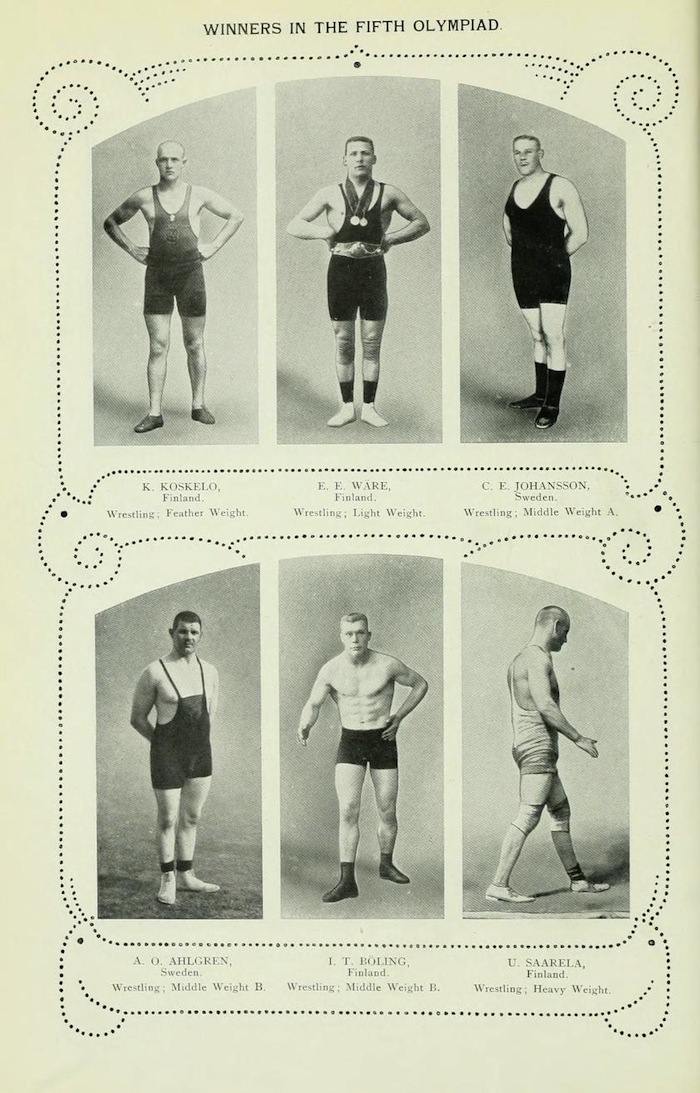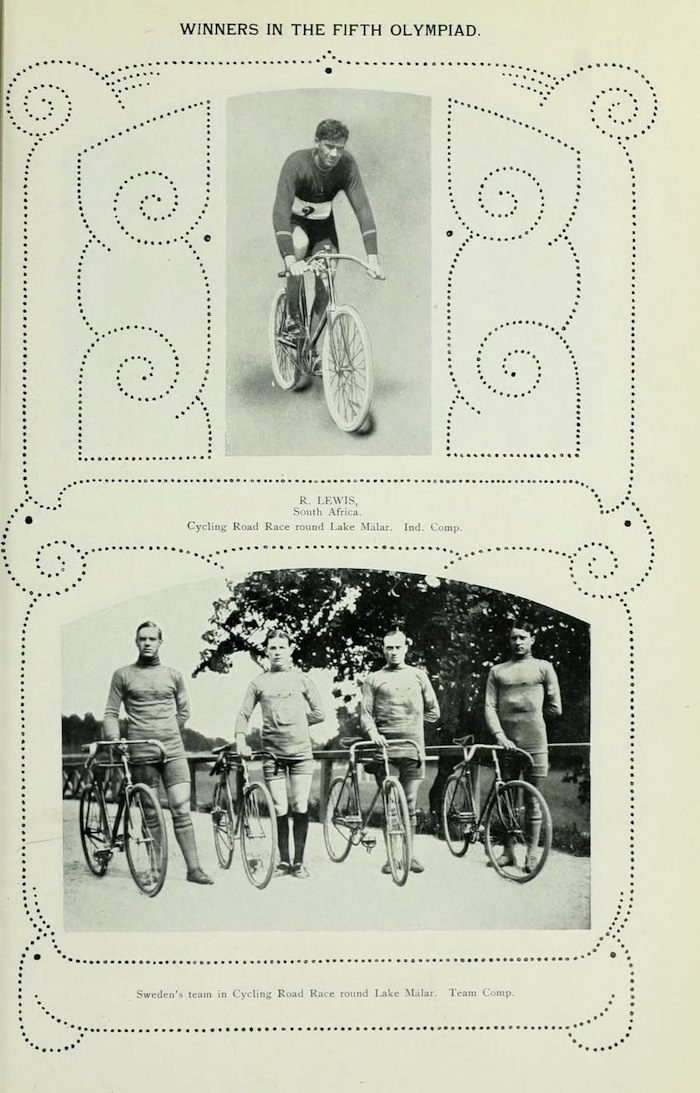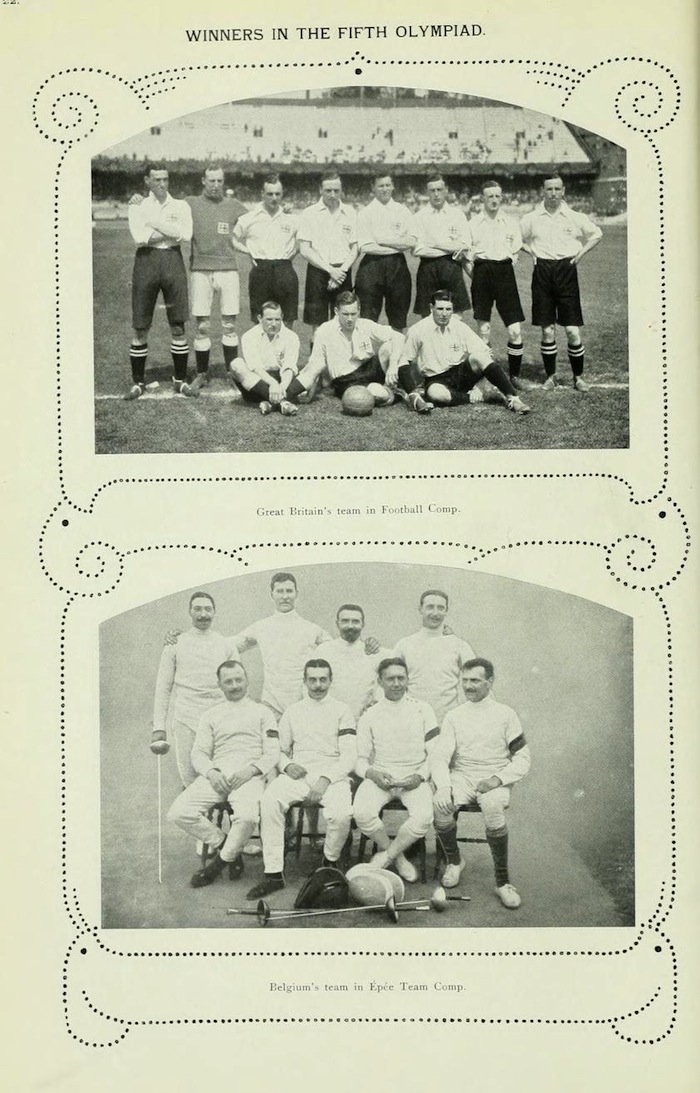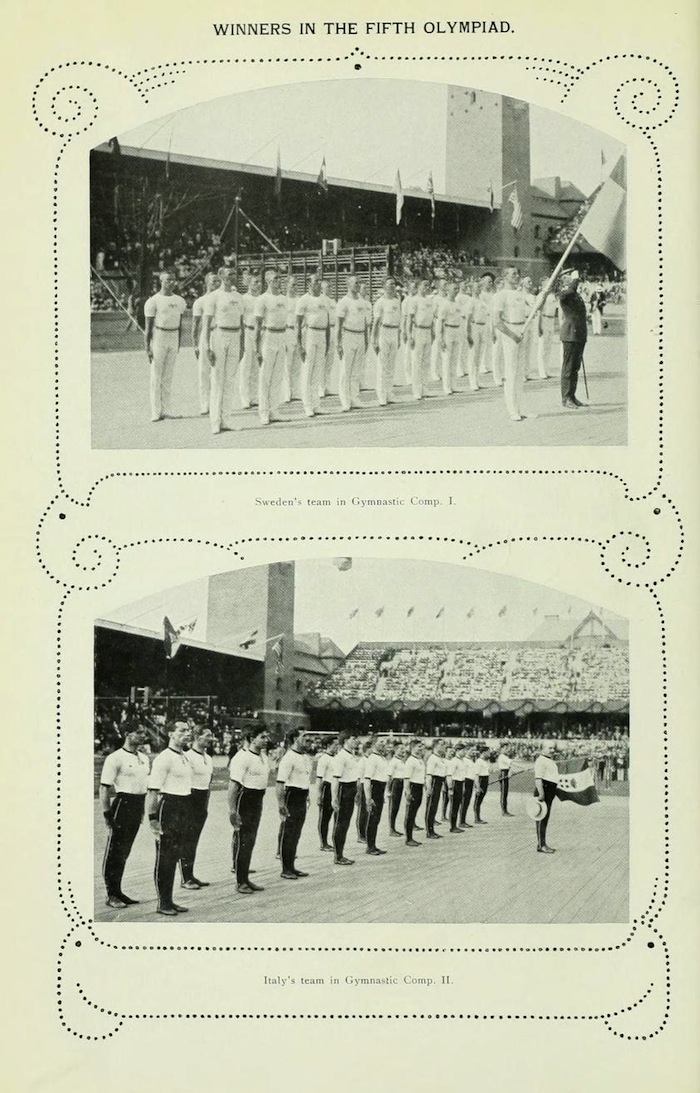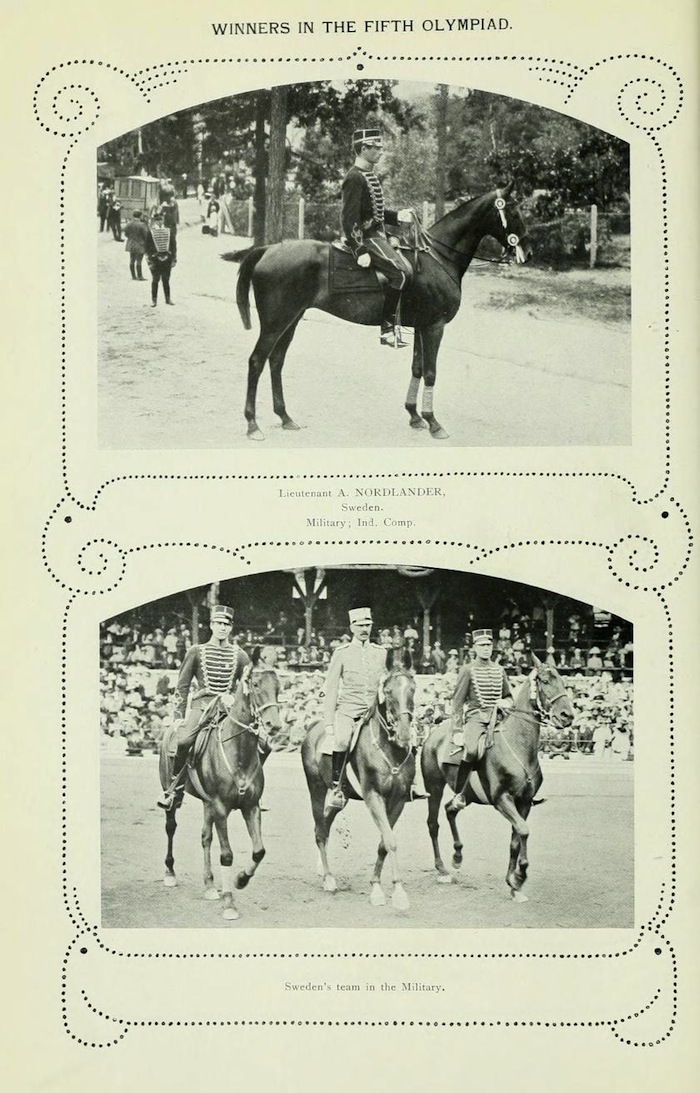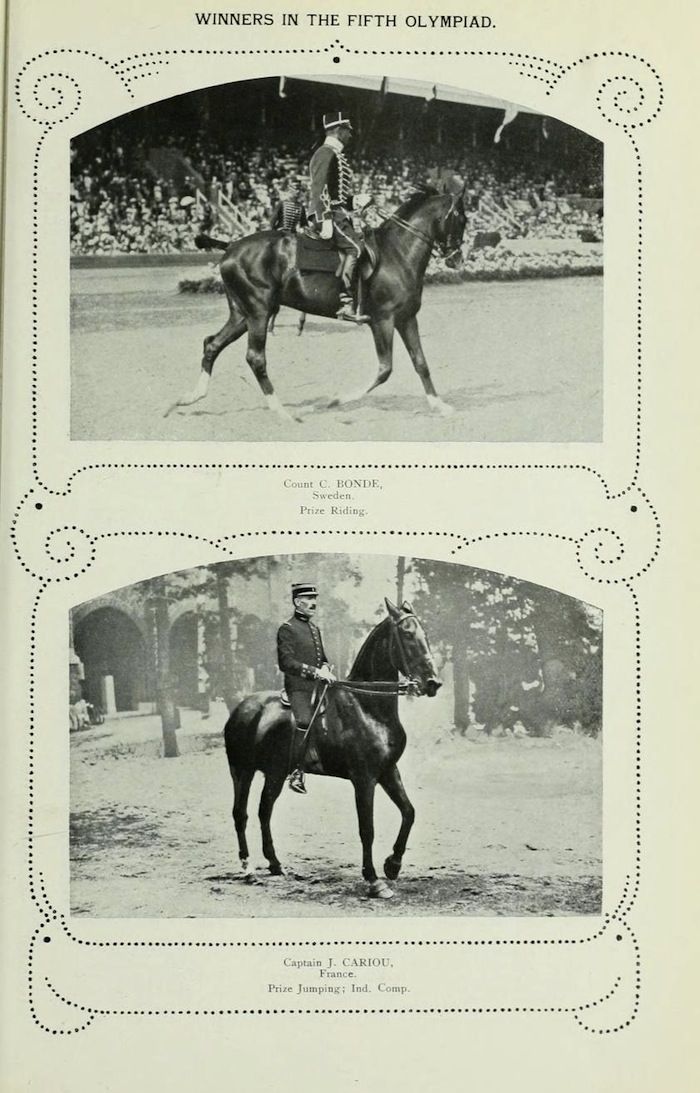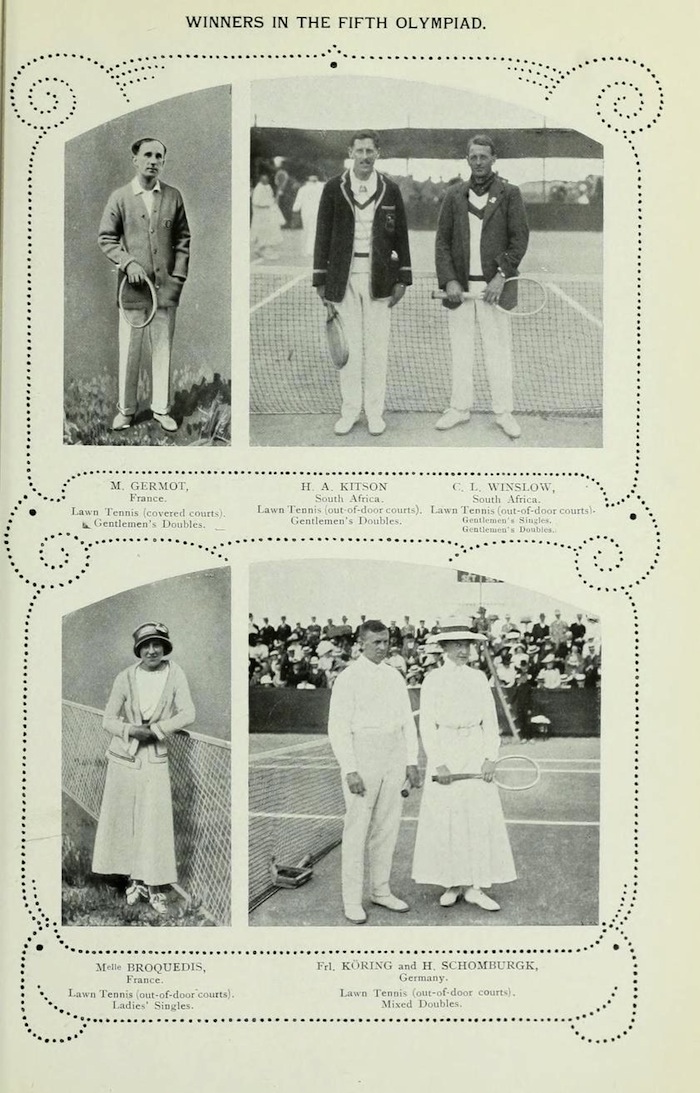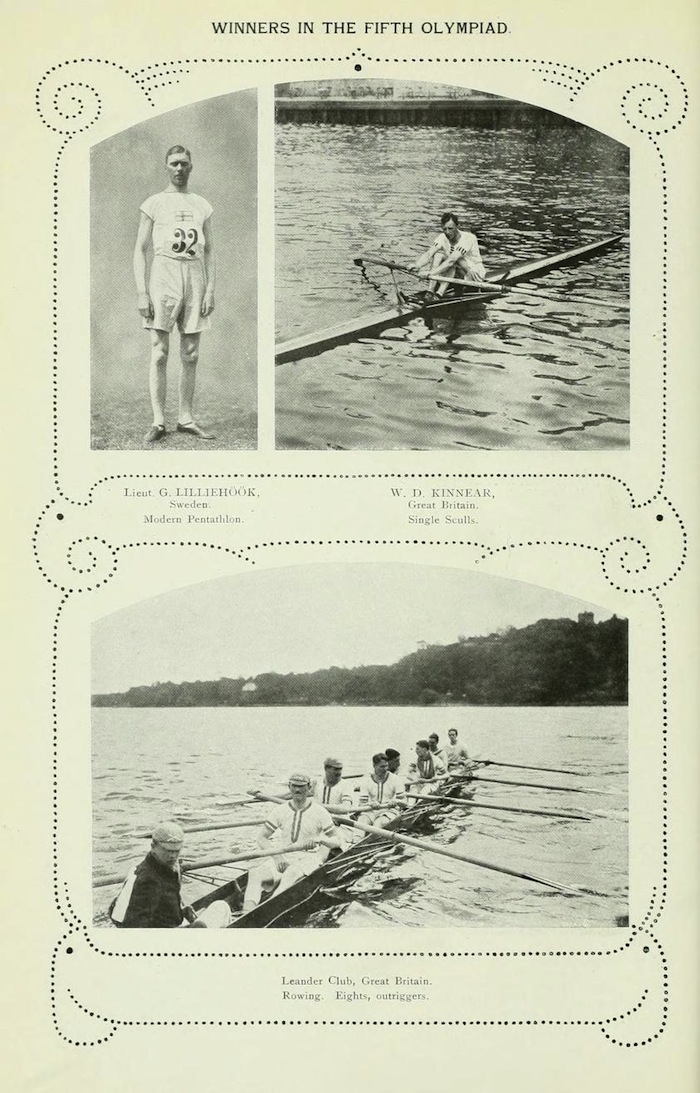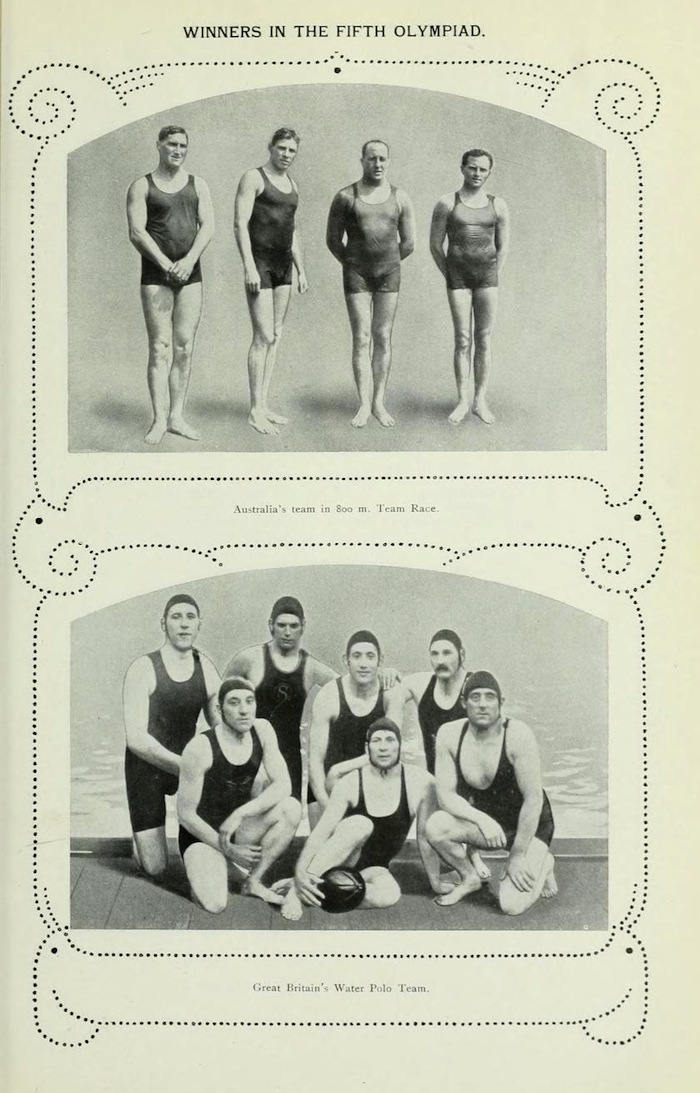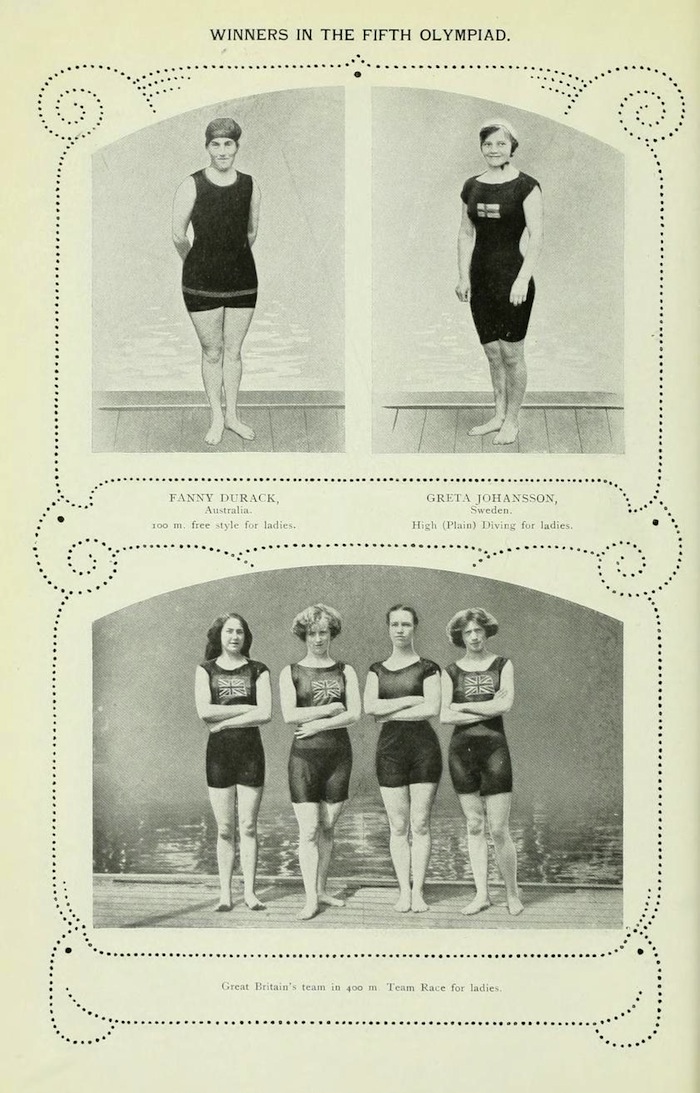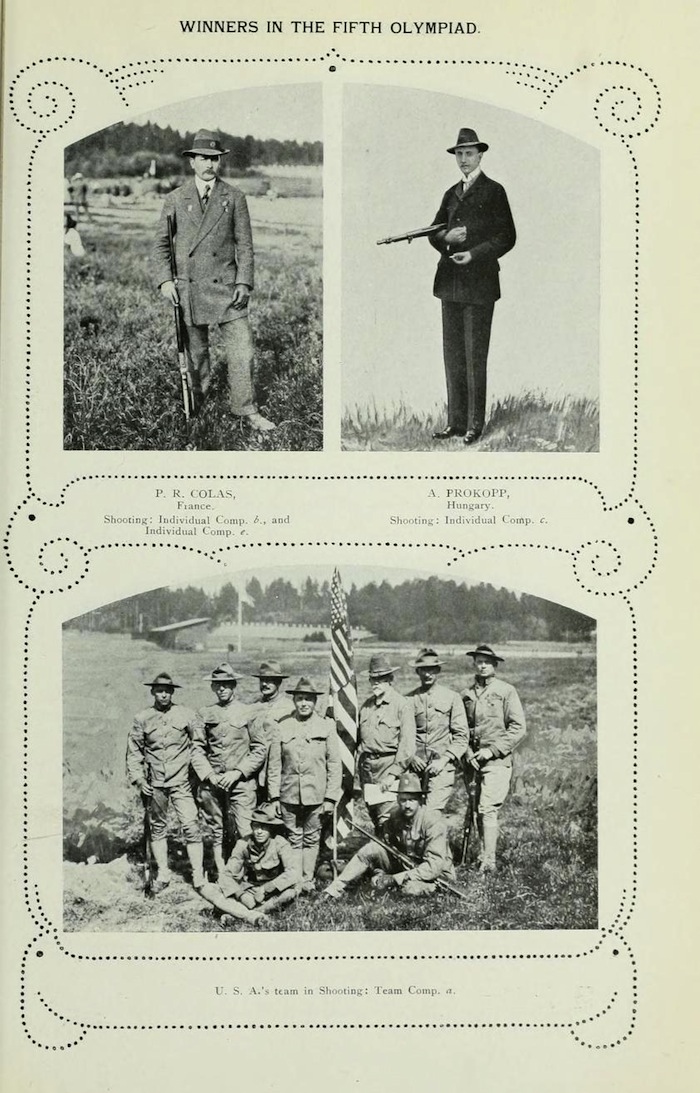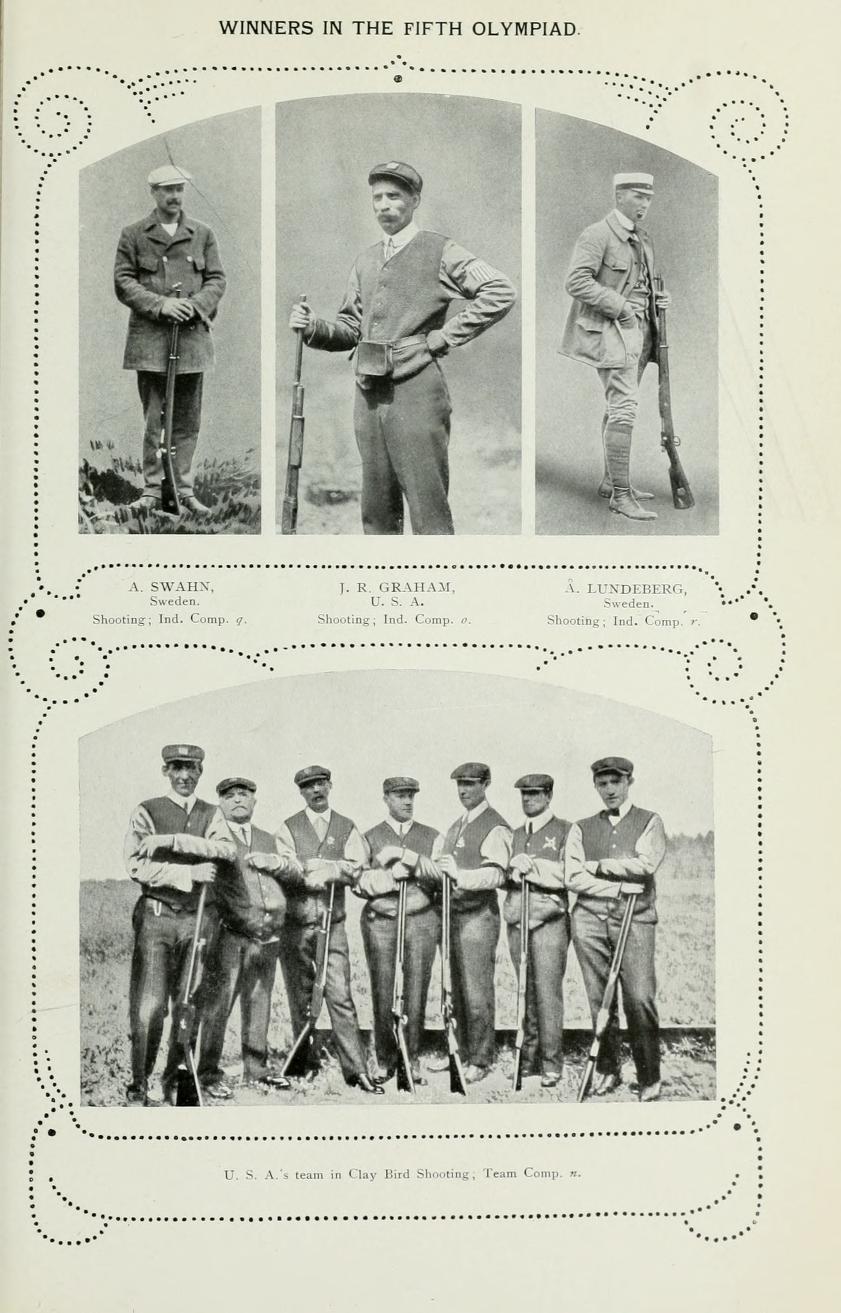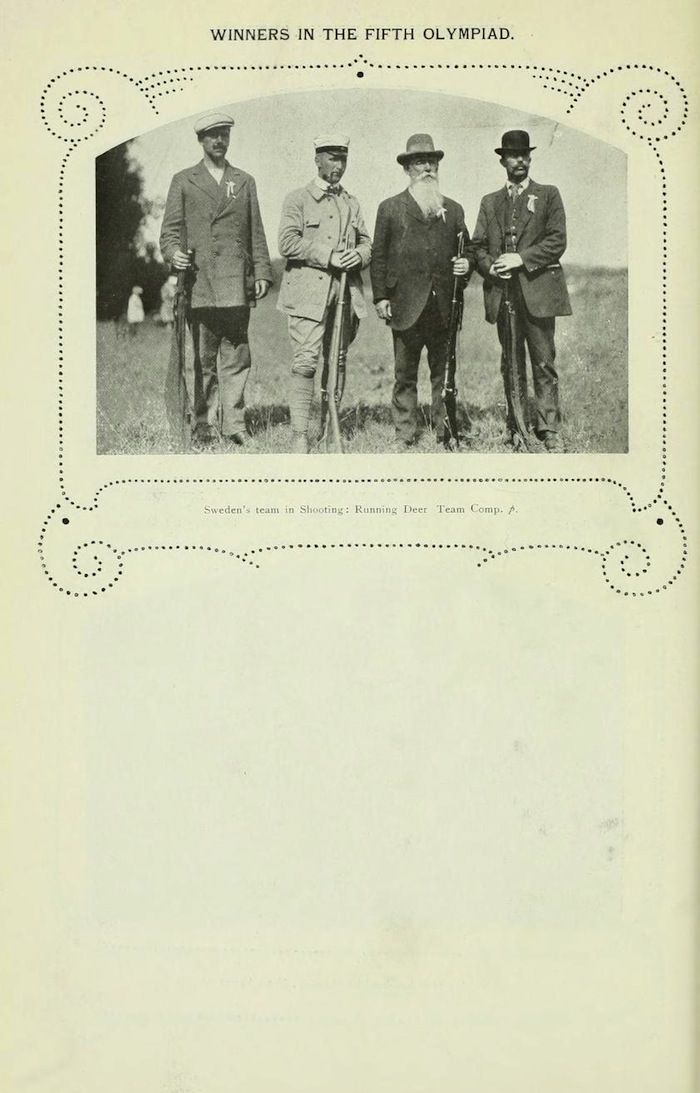When an exhausted Dorando Pietri was helped across the finishing line in the 1908 Olympics marathon, Sir Arthur Conan Doyle, creator of Sherlock Holmes, was there to write about it for the Daily Mail. Peter Lovesey explores how the drama and excitement of this event led Conan Doyle to become intimately involved with the development of the modern Olympics as we know it.

Dorando Pietri
being helped over the line by officials to come first in the marathon
at the London 1908 Olympic Games, only to be later disqualified.
There have been many exciting Olympic contests, but the 1908 race
which came to be known as Dorando’s marathon has passed into legend as
the most heart-rending. The image of the exhausted Italian runner
being assisted across the finish line and so disqualified appears in
almost every history of the Games. This was an extraordinary event.
Queen Alexandra was so touched by the harrowing scenes in the stadium
that she presented a special cup to Dorando Pietri. Irving Berlin
wrote a song called Dorando. The King had a horse named after the
runner. And a craze for marathon-running was born.
But now let us dispose of a canard. For years there has been
a story that Sir Arthur Conan Doyle, the creator of Sherlock Holmes,
was one of the officials who assisted Dorando at the finish of the
1908 Olympic marathon and so made the disqualification inevitable. He
has even been identified as a portly figure in a straw boater pictured
in the background of one of the most famous of all Olympic
photographs. Sadly for the romantics, the story isn’t true. The two
officials at either side of the athlete are Jack Andrew, the Clerk of
the Course, holding the megaphone, and Dr Michael Bulger, the chief
medical officer. The man in the background (and seen beside the
stricken Pietri in other photos) is probably another of the medical
team. Conan Doyle was seated in the stands.
His report in the Daily Mail (25 July, 1908) makes this clear.
Then again he collapsed, kind hands saving him from a
heavy fall. He was within a few yards of my seat. Amid stooping
figures and grasping hands I caught a glimpse of the haggard, yellow
face, the glazed, expressionless eyes, the lank black hair streaked
across the brow.
Conan Doyle had been commissioned by Lord Northcliffe to write a
special report of the race. “I do not often do journalistic work,” he
recalled in his memoirs, “but on the occasion of the Olympic Games of
1908 I was tempted, chiefly by the offer of an excellent seat, to do
the Marathon Race for the ‘Daily Mail’.” The almost melodramatic
scenes affected him deeply. “It is horrible, and yet fascinating, this
struggle between a set purpose and an utterly exhausted frame.”
Nothing like it had been seen to that time, though similar scenes
would occur at marathon finishes in the future. With remarkable
foresight, Conan Doyle finished his report with the words, “The
Italian’s great performance can never be effaced from our records of
sport, be the decision of the judges what it may.”
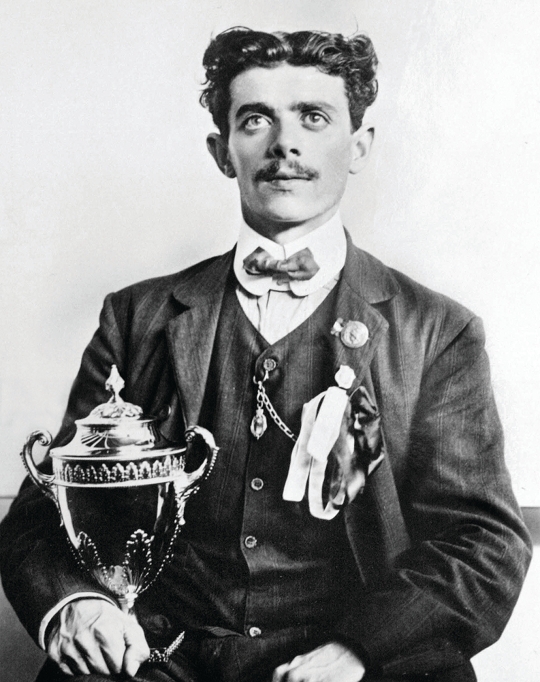
Dorando Pietri with the cup he was
presented by Queen Alexandra
It has been suggested that the cup presented next day by Queen
Alexandra was Conan Doyle’s idea, but this is another distortion of
the truth. In fact, Conan Doyle’s contribution was financial; he got
up a fund to raise money for Dorando Pietri. A letter published beside
his report in the Daily Mail stated:
I am sure that no petty personal recompense can in the
least console Dorando for the national loss which follows from his
disqualification. Yet I am certain that many who saw his splendid
effort in the Stadium, an effort which ran him within an inch of his
life, would like to feel that he carries away some souvenir from his
admirers in England. I should be very glad to contribute five pounds
to such a fund if any of the authorities at the Stadium would consent
to organise it.
Nobody seemed to bother that Dorando’s amateur status might be
sullied. The appeal raised the substantial sum of £308. Readers of the
paper were informed that the money would be used to enable the gallant
runner to start up as a baker in his own village. If the villagers
were relying on him for bread, they must have been disappointed. He
turned professional and cashed in on the marathon craze triggered by
his race. For much of the next year he was in the United States, only
returning to Italy in May, 1909. His travels lasted until 1912.
For Conan Doyle, that hot afternoon in the White City Stadium was an
epiphany that convinced him of the international significance of the
Olympic movement. As an all-round sportsman, he was quite an Olympian
himself. Between 1900 and 1907, he played cricket for the MCC, was a
useful slow bowler and once took the wicket of the finest batsman of
the century, W.G.Grace. He was a founder of Portsmouth Football Club
(1884) playing in goal and as a defender until he was forty-four; had
a golf handicap of ten; and in 1913 got to the third round of the
British amateur billiards championship. His knowledge of boxing,
particularly the prize-ring, is evident in his writing, particularly
Rodney Stone and The Croxley Master. And he is often credited with
popularising skiing during the years he spent in Switzerland. A plaque
celebrating his part in the history of Swiss skiing can be seen at
Davos.
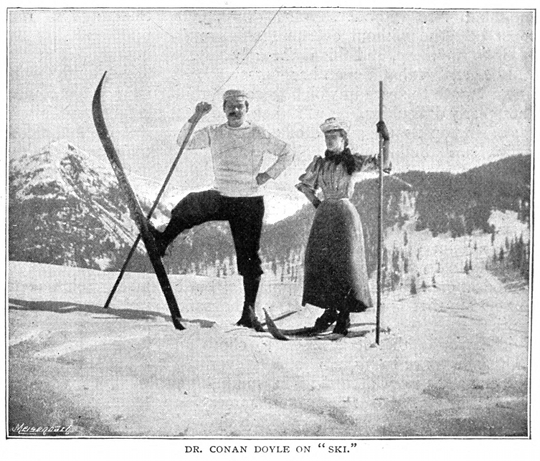
.
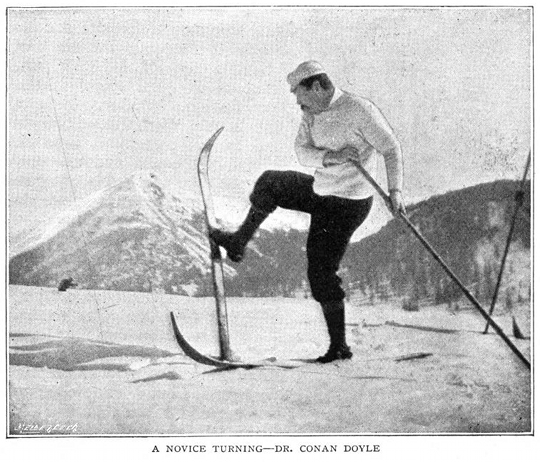
Images from “An Alpine Pass on ‘Ski’” by
Arthur Conan Doyle, The Strand Magazine, vol.8, no.48, pp 657-661
(1894)
In 1910 he accepted the presidency of the English Amateur Field Events
Association. Britain’s preoccupation with the more glamorous track
events had left the nation far behind the USA and the Nordic countries
in jumping and throwing. Britain’s showing in the Stockholm Olympic
Games in 1912, a mere two individual gold medals and five in team
sports, came as a shock to a nation that had dominated in the previous
century. To quote F.A.M.Webster, “a perfect wave of popular
indignation swept over the country, and Sir Arthur Conan Doyle . . .
had his attention drawn to the position.’ Conan Doyle’s own account
tells us that in the early summer of 1912 Lord Northcliffe sent him a
telegram “which let me in for about as much trouble as any
communication which I have ever received.” Northcliffe (who in 1908
had raised nearly £12,000 to bail out the London Olympic Games) said
Conan Doyle was the one man in Great Britain who could rally round the
discordant parties and achieve a united effort to restore the nation’s
Olympic status.
Conan Doyle was a strong patriot. It is often assumed he received his
knighthood because of his literary success, but Sherlock Holmes had
nothing to do with it. The honour was given mainly in recognition of
the writer’s much-translated booklet, The War in South Africa: Its
Causes and Conduct, a British response to international
criticisms of the nation’s role in the Boer War.
He began by writing to The Times (18 July, 1912) suggesting
that in future Britain should send a British Empire team, for “there
could not be a finer object lesson of the unity of the Empire than
such a team all striving for the victory of the same flag.” Twelve
days later came a fuller proposal with recognition that “liberal
funds” were needed to form, equip and train such a team. Annual or
bi-annual games should be held on the Olympic model, to accustom
athletes to the metric distances and to “abnormal events” such as the
discus and javelin. The Olympic Games should take priority over such
traditional British competitons as Bisley, Wimbledon and Henley. His
proposals on training were ahead of their time: “The team should be
brought together into special training quarters for as long a period
as possible before the Games, with the best advice always available to
help them.”
The response was unhelpful. Some of Northcliffe’s own papers attacked
the principle of investing money in amateur sport. Conan Doyle was not
a man to be silenced. In another letter to The Times (8
August, 1912), he appealed to all concerned to “let bygones be
bygones, and centre our efforts upon the future.” Never one to shirk
controversy, he pointed out that the British Olympic Council of about
50 members was too large for executive purposes. Instead, he proposed
“a nucleus of four or five from the present Olympic Association, with
as many more co-opted from outside.” Only then, he felt, would they be
in shape to appeal to the public for funds.
By March, 1913, the new Olympic Financial Committee was in place and
he was a member. The others were the chairman, J.E.K.Studd, the
cricketer and founder of the London Polytechnic; H.W.Forster, MP, a
future Governor-General of Australia, and first-class cricketer;
Edgar Mackay, the motor-boat pioneer; Bernard J.T.Bosanquet, a test
match cricketer now best remembered for inventing the “googly”; Arthur
E.D.Anderson, an Olympian from 1912; Arthur Robertson, another Olympic
athlete; Theodore Cook, the Olympic fencer; Percy Fisher, representing
the AAA; and J.C.Hurd, representing the swimmers.
Unfortunately for the fund-raisers, the state of the money market
during the Balkan War made this, in Conan Doyle’s words to the
Daily Express (24 May, 1913), “a very inopportune time to go
to the public for funds”. The project was put on ice. In July, the
Daily Express demanded to know when the appeal would be
launched. “An ill-timed appeal for funds would be disastrous … The
money market is still unfavourable,” replied Conan Doyle (4 July,
1913).
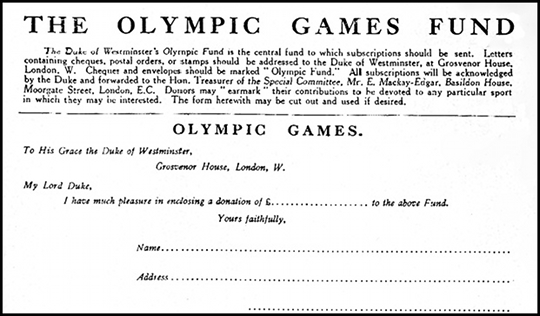
Donation form for the £100,000 Olympic
appeal – British Olympic Council, Aims and Objects of the Olympic
Games Fund (London, 1913) 43 – Source
Then he made an unfortunate decision to go on holiday and missed a
crucial meeting. In his absence, the committee launched the appeal,
not for ten thousand pounds, as Conan Doyle had planned, but a hundred
thousand. “I was horrified,” he wrote in Memories and
Adventures, “The sum was absurd, and at once brought upon us from
all sides the charge of developing professionalism … My position was
very difficult. If I protested now, it would go far to ruin the
appeal.”
Immediately there was a backlash. Frederic Harrison, head of the
Positivist movement in Britain, wrote (rather negatively) to The
Times (26 August, 1913), “The whole affair stinks of gate money
and professional pot hunting … The craze to collect Olympic dust bids
fair to be another case of ‘gate’ – professionalism – years of
specialist coaching. I should myself prefer to see Britain decline to
enter, as not liking the terms and devices on which the show is run.”
Conan Doyle’s response (The Times, 27 August, 1913) was a
cogently argued letter pointing out the scale of the scheme and the
practical requirements of improving national standards of physical
education. He concludes:
If Mr Harrison’s contention was that we should never have
gone in for the Olympic Games at all, he might find many to agree with
him. But, things being as they are, I would ask him to consider the
courses open to us. One is to retire in the face of defeat and to
leave the Colonies to put the Union Jack at the top where they can. As
a good sportsman I am sure Mr Frederic Harrison could not tolerate
that. A second is to continue with our present haphazard half-hearted
methods, and to see ourselves sink lower and lower from that third
place which we now occupy.
There was a real risk that the critics would torpedo the scheme and
necessitate Britain’s withdrawal from the next Olympics. In the same
issue of The Times came a letter from Nowell Smith, the Headmaster of
Sherborne. He had spoken to many lovers of sport, he claimed, and “We
are just ordinary, though, I fear, rather old-fashioned, Britons, and
we think these modern pseudo-Olympic Games are ‘rot’ and the newspaper
advertisements of them and the £100,000 fund for buying victories in
them, positively degrading.”
The controversy raged for weeks. The Times devoted a leading
article to the subject of veiled professionalism in the Olympics,
pointing out that even the most amateur of sports, such as the
University Boat Race, or schoolboy cricket, were funded to some
degree. More subversively, the humorous magazine, Punch,
published a piece strongly hostile to the Olympic Games.
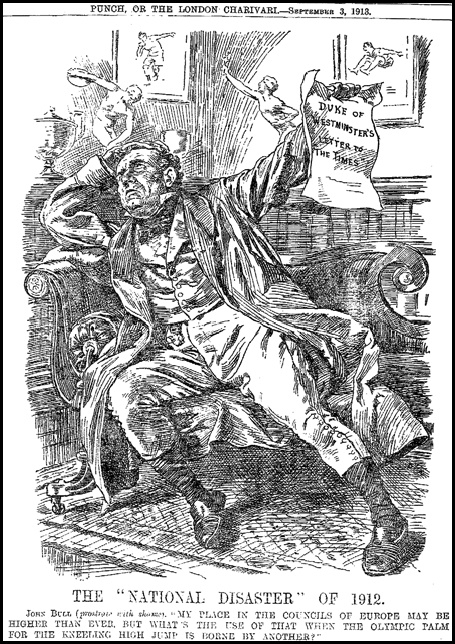
Satirical illustration poking fun at the
British Olympic Council’s idea that national pride could be restored
through Olympic success – Punch 145 (1913):209 – Source
Conan Doyle met the crucial question head on in The Times
(13 September, 1913): “I should like to ask one question and receive a
definite reply from all those persons, including Mr Punch, who are
making our Olympic task more difficult. It is this:- ‘Are you prepared
to stand down from the Berlin Games altogether?’”
He persuaded his chairman, J.E.K.Studd, that the right way to handle
this crisis was to invite the critics to a London hotel to debate the
issue of Britain’s participation. It was a turning point. Studd and
Conan Doyle each spoke at length and with honesty. Time, they argued,
was against them. The subscriptions were slow (by October 18th only
£9,500 was collected). But withdrawal from the Games would cast
Britain in the role of bad losers. They admitted that the target sum
of £100,000 was an “outside figure”. Studd, speaking for himself
alone, said he had only accepted the chairmanship in the hope that “if
successful, the work of the committee will enable Great Britain to
retire from future Olympic contests without loss of dignity or
prestige should she desire to do so.” Conan Doyle disagreed with this
view, and said so. As he wrote in a foreword at about the same time,
“No department of national life stands alone, and such a climb down in
sport as would be involved by a retirement from the Olympic Games
would have an enervating effect in every field of activity.”
Such straight talking was rare. The press agreed that the project
deserved their support, but the damage had been done. At the end of
November, 1913, Conan Doyle admitted, “The public seem apathetic on
the question. … Unless prompt and generous help comes to us, the
Committee will have dissolved, and the organisation, which has been
laboriously built up during the last year, will have gone to pieces.
The next few weeks will decide the matter.”
Of course, the matter was decided by events outside the control of
sportsmen and writers.
When the First World War was over, and Britain’s participation in the
1920 Olympics was debated, Conan Doyle was no longer at the forefront.
He was devoting his energies to another cause – spiritualism. Sadly,
the fund-raising experience had embittered him. “This matter was
spread over a year of my life, and was the most barren thing that I
ever touched, for nothing came of it, and I cannot trace that I ever
received one word of thanks from any human being. I was on my guard
against Northcliffe telegrams after that.”
But in a modest way, there had been results. An “Olympic sports
meeting”, over metric distances and including those “abnormal” field
events, the discus and javelin, was held at the Crystal Palace track
in 1913. And in February, 1914, Britain’s first paid national coach,
Walter Knox (a well-known professional with experience in Canada and
the USA) was appointed on a salary of £400 from the Olympic fund. The
AAA expanded its Championships to two days and added the 440yds
hurdles, triple jump, discus and javelin to its programme. Some
important principles had been established.
Peter Lovesey is a novelist, best known as creator of the Victorian
cop, ‘Cribb’, and one of Britain’s leading athletics historians,
author of The Official Centenary History Of The Amateur Athletic
Association (1979). His website: peterlovesey.com. The article above is an adaptation of one first appearing in the Journal of Olympic History, v.10 (2002).
Links to Work
 Sign up to get our free fortnightly newsletter which shall deliver
direct to your inbox the latest brand new article and a digest of the
most recent collection items. Simply add your details to the form
below and click the link you receive via email to confirm your
subscription!
Sign up to get our free fortnightly newsletter which shall deliver
direct to your inbox the latest brand new article and a digest of the
most recent collection items. Simply add your details to the form
below and click the link you receive via email to confirm your
subscription!



































































